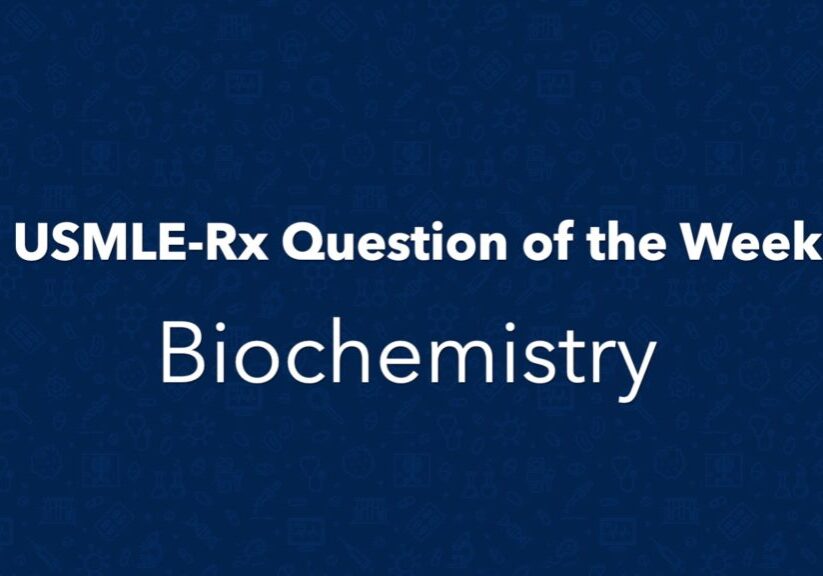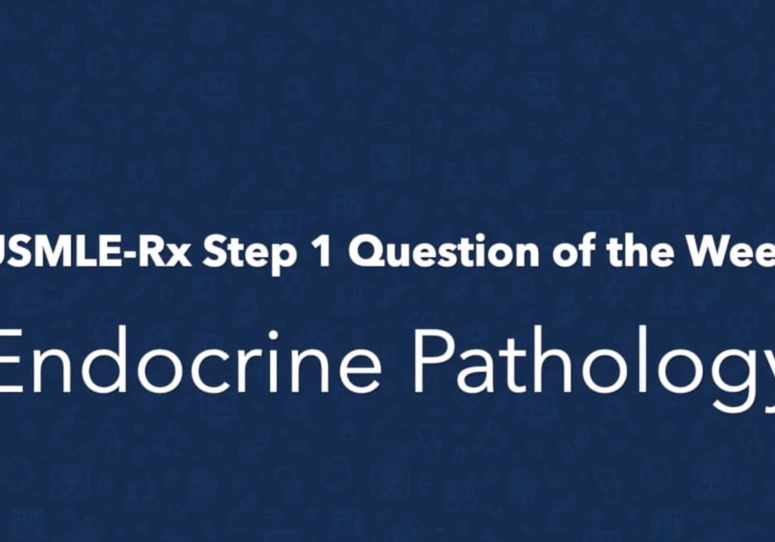Check out today’s Step 1 Qmax Question Challenge.
Know the answer? Post it below! Don’t forget to check back for an update with the correct answer and explanation (we’ll post it in the comments section below).
A 58-year-old man with a history of alcohol abuse presents to the hospital with a protuberant abdomen, slurring of speech, and confusion. On physical examination there are multiple spider angiomata on his chest, and a fluid wave is elicited on abdominal examination. When his hands are extended outward, a flapping tremor appears. He is promptly treated with medications to reduce the level of toxic metabolite responsible for his symptoms.
Normally, where do the initial steps for detoxification of this metabolite take place?
A. Hepatocyte cytoplasm
B. Hepatocyte endoplasmic reticulum
C. Hepatocyte mitochondria
D. Kupffer cell cytoplasm
E. Portal circulation
Want to know the ‘bottom line?’ Purchase a USMLE-Rx Subscription and get many more features, more questions, and passages from First Aid, including images, references, and other facts relevant to this question.
This practice question is an actual question from the USMLE-Rx Step 1 Qmax test bank. For more USMLE Step 1 prep, subscribe to our First Aid Step 1 Flash Facts and First Aid Step 1 Express Videos video series. Score the best deal on all three products as a bundle with USMLE-Rx 360 Step 1.





C
C
Urea Cycle starts in Mitochondrion
E
E
The correct answer is C. This patient is presenting with decompensated liver failure and signs of hepatic encephalopathy. His protuberant abdomen with a fluid wave, spider angiomata, and alcohol history all point toward portal hypertension caused by alcoholic cirrhosis. His confusion, slurring of speech, and flapping of hands when outstretched (asterixis) are all signs of encephalopathy due to buildup of ammonia. Patients presenting with hepatic encephalopathy are often treated with agents to reduce ammonia levels, including lactulose and antibiotics, both of which work in the gut to bind ammonia and eliminate urease-producing bacteria, respectively.
In a healthy person, ammonia (the potentially toxic by-product of protein degradation) is converted to urea in the liver. Urea is a more neutral compound that is eliminated by the kidney in the urine. The conversion from ammonia to urea constitutes the urea cycle, which takes place in hepatocytes. The initial steps of the urea cycle (the convergence of ammonia and carbon dioxide to form carbamoyl phosphate; the convergence of carbamoyl phosphate and ornithine to form citrulline) all occur in the mitochondrial matrix of hepatocytes. Citrulline is then exported from the mitochondria, and the ensuing steps occur in the cytosol, where urea is ultimately generated.
A is not correct. Many steps of the urea cycle occur in the hepatocyte cytoplasm. However, the initial steps involving ammonia occur in the hepatocyte mitochondrial matrix.
B is not correct. The smooth endoplasmic reticulum of hepatocytes is the site of detoxification of many toxins. However, alcohol dehydrogenase acts in the cytosol.
D is not correct. Kupffer cells are specialized macrophages lining the sinusoids of the liver. They have immunologic function and secrete cytokines, as well as ingest antigens. They do not have a role in clearance of ammonia.
E is not correct. Ammonia produced by gut bacteria is absorbed into the portal circulation where it then travels to the liver to be converted into urea via the urea cycle. No molecular conversion takes place while ammonia travels through the portal circulation.
Hey there I like it whenever people come together and share views. Great site, continue the good work! gracias
Fantastic Info! But I???¨º?¨¨m having some trouble trying to load your blog. I have read it many times just before and never gotten a thing like this, but now when I attempt to load some thing it just takes a bit whilst (5-10 minutes ) after which just stops. I hope i don???¨º?¨¨t have spyware or a thing. Does anyone know what the difficulty might be?